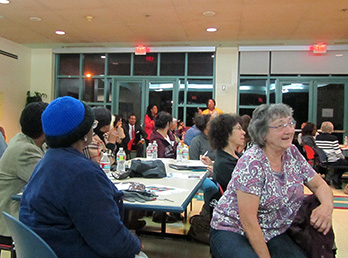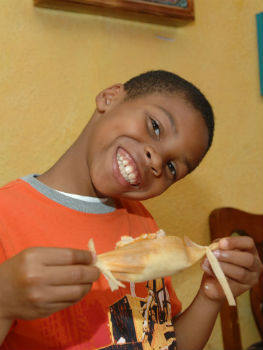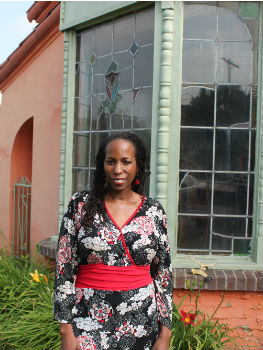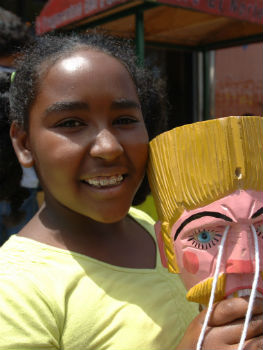The stretch of Slauson Avenue between Angeles Vista and La Brea used to be the thriving economic heart of the surrounding middle-class neighborhood. Over time, the bank, grocery store, and many other businesses dwindled, causing residents to travel over the hills to Crenshaw and other neighborhoods for many of its services. On a recent wintry Saturday, LA Commons worked with local merchants and County Supervisor Mark Ridley-Thomas to kick off a re-branding and revitalization of the former “Main Street” with a holiday block party—the Slauson Stroll.
Slauson Stroll—Looking for Main Street in South LA
New vision of Slauson Avenue in South Los Angeles
Residents in South Los Angeles gathered together Monday evening to share their fondest memories of being on Slauson Avenue, while proposing a vision of what they see Slauson becoming, at Junior Blind of America’s center.
The meeting, held in partnership with LA Commons and the Los Angeles County Arts Commission, was to help shape the development of the Slauson Corridor Revitalization Project, spearheaded by the Office of Supervisor Mark Ridley-Thomas. 
“I don’t want to go to Culver City to get a nice sandwich. I want to go right here, where we are and have a sense of pride in it,” said resident Roy Wheatle.
Everyone at the meeting agreed that they wanted the new Slauson Corridor, between Overhill Drive and Angeles Vista Boulevard, to offer more shopping and outdoor dining experiences, along with a pedestrian friendly atmosphere.
Karly Katona, deputy for sustainability for the office of Mark Ridley-Thomas, said making a livable, walkable community requires the input of its residents.
She said it was essential for those involved in the planning process to receive feedback from residents and local business owners to understand their needs and wants.
Erin Stennis, deputy to Supervisor Ridley-Thomas, added that it would have been impossible for the district to implement changes without feedback from the community. 
“This is a community that has traditionally been engaged,” said Stennis.
Supervisor Mark Ridley-Thomas said the revitalization is also an effort to “bring value to the land use and space.”
“My role is essentially one to catalyze the process, to attract attention to it and make investments into it with the resources of Los Angeles County,” said Ridley-Thomas.
He added that the project was not a publicly funded project, but one that uses the public’s input to help attract private investors.
“We are teeing this up in a way that is worthy of this environment…I don’t see that to be a pipe dream,” said Ridley-Thomas. “This is going to be an emerging market that will not be ignored.”
A portion of the meeting was dedicated to hearing development plans from student-led teams at USC and UCLA, as part of a real estate challenge organized by the National Association of Industrial and Office Properties (NAIOP) and sponsored by Ridley-Thomas.
The challenge is a 6-week case competition where students from both schools are tasked with solving a development issue, such as the Slauson Corridor.
This is the 15th year the challenge has taken place between UCLA and USC tied with 7 wins each, which makes the Slauson project a tie-breaker competition, according to Ridley-Thomas.
The winning team has not been announced, but residents applauded both schools for the research put into their presentation.
Both teams proposed a space that would seamlessly mix dining and retail shops with senior independent living.
USC proposed a two-story parking structure with multiple entrances for residents and visitors.
UCLA had surface level parking citing that many grocery stores preferred it to structured parking due to safety and its ease of access. 
For residents, the most anticipated portion of both presentations was hearing the possibility of specialty retail grocery store, Trader Joe’s, making its home inside the renovated corridor.
USC believed the area had the potential to attract Trader Joe’s.
While UCLA said based on their meetings with the company, it would be difficult and proposed building a Lazy Acres Market, an upscale grocery store chain operated by Bristol Farms, which caused some in the crowd to become upset.
Ridley-Thomas pointed out that it was important for residents to have not one but several choices in where they would like to shop.
The next meeting, discussing the environmental impact report for the Slauson Avenue streetscape, is scheduled to take place on Monday, Dec. 3 at 7 p.m. at Junior Blind of America.
Abrazando the Spanish language
By Patrick Thelen
Associate Editor

Photo Credit: Angela Daves Haley
Over 52 million people of Hispanic origin are currently living in the United States. By 2050, the number is expected to reach 132.8 million. This demographic transformation is clearly visible for those living in LA. According to the 2010 US Census, there are 4.7 million people of Hispanic origin residing in Los Angeles County. In other words, this group makes up 48.1% of the County´s population.
What exactly do these numbers mean? For Carlene Davis, an experienced policy and management professional in the public and non-profit sectors, they represent an opportunity to embrace a new reality, and confront change in a positive and enriching manner.
In 2003, as a volunteer effort in response to rising tensions from the changing racial and ethnic landscapes of Los Angeles’s schools, neighborhoods and communities, Ms. Davis founded Abrazar. Created on the premise of the unifying power of language, Abrazar –which means embrace in Spanish –is focused on utilizing Spanish-language learning as a vehicle to facilitate positive inter-group relations between African-American and Latino youth, particularly in South Los Angeles.
Although the project has been dormant during the last five years, Abrazar has just announced a community host partnership with Frederick Douglass Academy Middle School. This alliance will allow Ms. Davis’ venture to relaunch in January, 2013, the ¡Listos! After-school Program and the ¿Cómo Se Dice? Weekend Academy –the latter will be open to the general public.
The ¡Listos! After-school Program is both a Spanish-language learning and cultural awareness program for elementary school children. In Spanish, listos means both “smart” and “ready.”
The ¿Cómo se Dice? Weekend Academy is a Foreign Language Experience (FLEX) Spanish program for children between six and eleven years old. The goal is to teach Spanish in a fun way that will prepare students to acquire a second language over time.
Bridging the gap between two communities
“In the 2000’s, as the demographics of South LA were continuing to switch from African American to Latino, we started to witness an increase in black-brown tension,” says Ms. Davis. As a native of Los Angeles, she did not like what she was seeing and decided to build a bridge between both communities. She created an educational advocacy campaign, and told neighbors that their children should learn the new language.

Carlene Davis, founder and director of Abrazar.
“My goal is to change the hearts of the community. Both African Americans and Latinos need to learn from each other,” says Ms. Davis. “Language is a powerful social and cultural tool that establishes bonds between diverse communities.”
“I think a program like Abrazar affects relationships between the two groups by breaking down barriers,” says Susan Plann, Professor of Chicano/a Studies at UCLA and an Advisory Board Member of Abrazar. “One of my students wrote an honors thesis on the program, and part of her research involved interviewing kids from the classes. Many said that they wanted to learn more Spanish and practiced it with their Spanish speaking neighbors. They were really into it. Programs like these demystify ‘the other’ and we need more of them.”
Abrazar started off as a vocational side job for Ms. Davis. Her full-time job was very time consuming and did not allow her to dedicate the time and energy needed to maintain a sustainable project. “I was just doing what I could to bring this to the community. I wasn´t thinking of developing a long term program.”
Ms. Davis is currently working as a consultant with the Coalition for Educational Partnerships. This job has provided her the required time and liberty to relaunch Abrazar and confront future challenges and opportunities.
In addition to her partnership with Frederick Douglass Academy Middle School, Ms. Davis will continue her previous affiliations with LA Commons and The Foundation for Second Chances. She is also affiliated with the International Society of Black Latinos, an organization dedicated to educating the community about the cultural and historical richness of the African Diaspora in Latin America and the presence of vibrant Afro-Latino communities in the U.S.

Photo Credit: Angela Daves Haley
The relationship with the International Society of Black Latinos is highly relevant in Abrazar’s educational program. “At first we would only focus in teaching Spanish. Over time we added the cultural content and gave it an Afro-Latino focus. Although Mexico is an important part of our curriculum, we also spend a lot of time teaching the culture and music of Spanish speaking countries with a strong African presence.”
The economy
Although Ms. Davis’ mission is to develop a cultural experience that will unite both communities, she is also aware that teaching children a second language will benefit them the day they start looking for jobs. “In a city like Los Angeles, in which Spanish is the unofficial second language, a person that knows both languages will be preferred in any profession that involves human interaction. However, Abrazar´s vision is to prepare a future generation of global citizens.”














